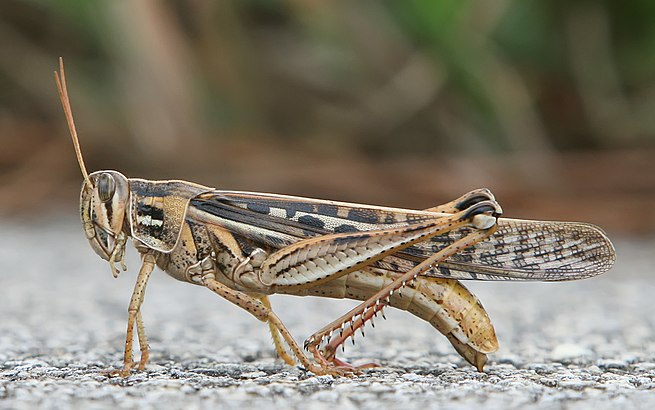
-
Grasshopper
Grasshoppers are a group of insects belonging to the suborder Caelifera. They are among what is probably the most ancient living group of chewing herbivorous insects, dating back to the early Triassic around 250 million years ago.
Grasshoppers are typically ground-dwelling insects with powerful hind legs which allow them to escape from threats by leaping vigorously. As hemimetabolous insects, they do not undergo complete metamorphosis; they hatch from an egg into a nymph or “hopper” which undergoes five moults, becoming more similar to the adult insect at each developmental stage. At high population densities and under certain environmental conditions, some grasshopper species can change color and behavior and form swarms. Under these circumstances, they are known as locusts.
Grasshoppers are plant-eaters, with a few species at times becoming serious pests of cereals, vegetables and pasture, especially when they swarm in their millions as locusts and destroy crops over wide areas. They protect themselves from predators by camouflage; when detected, many species attempt to startle the predator with a brilliantly-coloured wing-flash while jumping and (if adult) launching themselves into the air, usually flying for only a short distance. Other species such as the rainbow grasshopper have warning coloration which deters predators. Grasshoppers are affected by parasites and various diseases, and many predatory creatures feed on both nymphs and adults. The eggs are the subject of attack by parasitoids and predators.
Grasshoppers have had a long relationship with humans. Swarms of locusts can have devastating effects and cause famine, and even in smaller numbers, the insects can be serious pests. They are used as food in countries such as Mexico and Indonesia. They feature in art, symbolism and literature.
-
Locust
Locusts are certain species of short-horned grasshoppers in the family Acrididae that have a swarming phase. These insects are usually solitary, but under certain circumstances they become more abundant and change their behaviour and habits, becoming gregarious. No taxonomic distinction is made between locust and grasshopper species; the basis for the definition is whether a species forms swarms under intermittently suitable conditions. These grasshoppers are innocuous, their numbers are low, and they do not pose a major economic threat to agriculture. However, under suitable conditions of drought followed by rapid vegetation growth, serotonin in their brains triggers a dramatic set of changes: they start to breed abundantly, becoming gregarious and nomadic (loosely described as migratory) when their populations become dense enough. They form bands of wingless nymphs which later become swarms of winged adults. Both the bands and the swarms move around and rapidly strip fields and cause damage to crops. The adults are powerful fliers; they can travel great distances, consuming most of the green vegetation wherever the swarm settles.Locusts have formed plagues since prehistory. The ancient Egyptians carved them on their tombs and the insects are mentioned in the Iliad, the Bible and the Quran. Swarms have devastated crops and been a contributory cause of famines and human migrations. More recently, changes in agricultural practices and better surveillance of locations where swarms tend to originate, have meant that control measures can be used at an early stage. The traditional means of control are based on the use of insecticides from the ground or the air, but other methods using biological control are proving effective.
Swarming behaviour decreased in the 20th century, but despite modern surveillance and control methods, the potential for swarms to form is still present, and when suitable climatic conditions occur and vigilance lapses, plagues can still occur. Locusts are large insects and convenient for use in research and the study of zoology in the classroom. They are also edible insects; they have been eaten throughout history and are considered a delicacy in many countries. The word “locust” is derived from the Latin Vulgate locusta, meaning grasshopper.
-
Grasshopper (noun)
A herbivorous insect of the order Orthoptera noted for its ability to jump long distances and for its habit of communicating by stridulation.
-
Grasshopper (noun)
A cocktail made with crème de menthe and optionally with crème de cacao.
-
Grasshopper (noun)
a young student in initial stages of training who has been chosen on account of their obvious talent
-
Grasshopper (noun)
In ordinary square or upright pianos of London make, the escapement lever or jack, so made that it can be taken out and replaced with the key.
-
Locust (noun)
Any of the grasshoppers, usually swarming, in the family Acrididae that are very destructive to crops and other vegetation.
-
Locust (noun)
especially, the migratory locust (ver=161006)
-
Locust (noun)
(ver=161006) (does not swarm)
-
Locust (noun)
(ver=161006)
-
Locust (noun)
(ver=161006)
-
Locust (noun)
(ver=161006)
-
Locust (noun)
(ver=161006)
-
Locust (noun)
(ver=161006)
-
Locust (noun)
(ver=161006)
-
Locust (noun)
(ver=161006)
-
Locust (noun)
(ver=161006) – extinct
-
Locust (noun)
(ver=161006) – Australia
-
Locust (noun)
(ver=161006 spp.)
-
Locust (noun)
A locust tree.
-
Locust (verb)
To come in a swarm.
